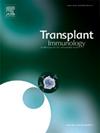整合素L (ITGAL)序列(lncRNA-ITGAL)长链非编码rna (lncRNA-ITGAL)在角膜移植免疫排斥过程中CD4+ T细胞分化中的调控机制
IF 1.6
4区 医学
Q4 IMMUNOLOGY
引用次数: 0
摘要
目的:角膜失明仍然是全球视力障碍的主要原因,影响约617万人。高风险角膜移植与排异率高达50% %相关,需要开发新的治疗策略来补充或加强传统的免疫抑制治疗,包括皮质类固醇和钙调磷酸酶抑制剂。本研究旨在研究整合素L (integrin alpha L, ITGAL)序列转录的长链非编码rna (lncRNA-ITGAL)在角膜移植后免疫排斥过程中对CD4+ T细胞分化的调控功能。方法:将Sprague Dawley大鼠(n = 20只)分为对照组和排斥组。移植后2周评估角膜排斥指数。采用苏木精和伊红染色进行组织病理学评价。通过RNA测序分析lncRNA和信使RNA的差异表达谱。流式细胞术定量测定人外周血单核细胞中Th1、Th2和Th17亚群。采用定量逆转录聚合酶链反应检测lncRNA-ITGAL、miR-378a-3p、肿瘤坏死因子受体相关因子1的表达。通过荧光原位杂交和免疫组织化学检测空间相互作用。结果:排斥组角膜组织出现明显的间质水肿和不透明(p )结论:lncRNA-ITGAL通过miR-378a-3p/TRAF1轴调节Th1、Th2和Th17亚群的分化,突出了其作为改善角膜移植存活的治疗靶点的潜力。本文章由计算机程序翻译,如有差异,请以英文原文为准。
The regulatory mechanism of long non-coding RNAs (lncRNAs) of integrin alpha L (ITGAL) sequences (lncRNA-ITGAL) in CD4+ T cell differentiation during immune rejection of corneal transplants
Objective
Corneal blindness remains a major global contributor to visual impairment, affecting approximately 6.17 million individuals. High-risk corneal transplantation is associated with rejection rates of up to 50 %, necessitating the development of new therapeutic strategies to complement or enhance conventional immunosuppressive treatments, including corticosteroids and calcineurin inhibitors. This study aimed to examine the regulatory function of long non-coding RNAs (lncRNAs) transcribed from integrin alpha L (ITGAL) sequences (lncRNA-ITGAL) in CD4+ T cell differentiation during immune rejection following corneal transplantation.
Methods
Sprague Dawley rats (n = 20) were assigned to either a control or rejection group. Corneal rejection indices were assessed two weeks post-transplantation. Histopathological evaluation was performed using hematoxylin and eosin staining. RNA sequencing was conducted to analyze differentially expressed lncRNA and messenger RNA profiles. Flow cytometry was used to quantify Th1, Th2, and Th17 subsets in human peripheral blood mononuclear cells. Quantitative reverse transcription polymerase chain reaction was employed to measure the expression of lncRNA-ITGAL, miR-378a-3p, and tumor necrosis factor receptor-associated factor 1. Spatial interactions were examined through fluorescence in situ hybridization and immunohistochemistry.
Results
Corneal tissues in the rejection group exhibited significant stromal edema and opacity (p < 0.05). RNA sequencing identified 7057 differentially expressed lncRNAs and 5485 differentially expressed mRNAs (p < 0.05). The expression of lncRNA-ITGAL was positively correlated with TRAF1 and negatively correlated with miR-378a-3p. Flow cytometry demonstrated that overexpression of lncRNA-ITGAL increased the proportions of Th1, Th2, and Th17 subsets (p < 0.05), whereas its knockdown reduced these subsets. In corneal tissues, upregulated expression of lncRNA-ITGAL and TRAF1, along with downregulated miR-378a-3p, was observed in the rejection group (p < 0.05). Immunohistochemical analysis confirmed elevated tumor necrosis factor receptor-associated factor 1 (TRAF1) expression in the corneal epithelium (p < 0.05).
Conclusion
lncRNA-ITGAL modulates the differentiation of Th1, Th2, and Th17 subsets through the miR-378a-3p/TRAF1 axis, highlighting its potential as a therapeutic target for improving corneal graft survival.
求助全文
通过发布文献求助,成功后即可免费获取论文全文。
去求助
来源期刊

Transplant immunology
医学-免疫学
CiteScore
2.10
自引率
13.30%
发文量
198
审稿时长
48 days
期刊介绍:
Transplant Immunology will publish up-to-date information on all aspects of the broad field it encompasses. The journal will be directed at (basic) scientists, tissue typers, transplant physicians and surgeons, and research and data on all immunological aspects of organ-, tissue- and (haematopoietic) stem cell transplantation are of potential interest to the readers of Transplant Immunology. Original papers, Review articles and Hypotheses will be considered for publication and submitted manuscripts will be rapidly peer-reviewed and published. They will be judged on the basis of scientific merit, originality, timeliness and quality.
 求助内容:
求助内容: 应助结果提醒方式:
应助结果提醒方式:


